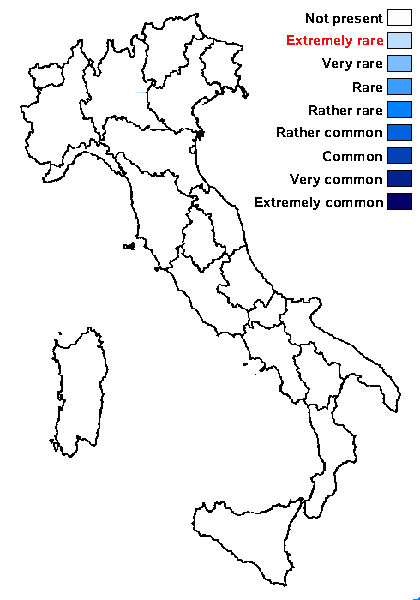Parmelia encryptata A. Crespo, Divakar & M.C. Molina
in Molina & al., Lichenologist, 43: 595, 2011
Synonyms:
Distribution:
Description: Thallus foliose, heteromerous, dorsiventral, rather loosely attached, usually forming 4-10(-20) cm wide, distinct rosettes. Lobes sublinear, contiguous to imbricate, elongate, flat, separate, 2-5 mm wide, with truncate apices. Upper surface grey, usually epruinose, rarely faintly white-pruinose in marginal parts, becoming cracked along prominent, elongated pseudocyphellae which give rise to granular soredia arranged in laminal, linear, non-excavated soralia. Lower surface black, with simple rhizines, except in the central part of thalli where they are squarrose, the rhizines present also along the margins. Upper cortex paraplectenchymatous, of 2-6 layers of densely packed cells, with a usually non-pored epicortex, the cell walls with isolichenan; medulla white; algal layer continuous; lower cortex paraplectenchymatous, thinner than upper cortex. Apothecia and pycnidia unknown. Photobiont chlorococcoid. Spot tests: upper cortex K+ yellow (but often slowly turning orange-red due to medullary substances), C-, KC-, P+ yellow; medulla K+ yellow turning orange-red, C-, KC-, P+ orange, UV-. Chemistry: upper cortex with atranorin and chloroatranorin; medulla with salazinic acid (major) and consalazinic acid (minor).Note: this cryptic, mainly epiphytic, apparently rare species with a scattered known distribution in Spain, Switzerland, and Central Europe, is hardly distinguishable from P. sulcata on the basis of morphological characters. Its ecology is still poorly known, but the species seems to be bound to old forests. It occurrence in Italy is possible.
Growth form: Foliose
Substrata: bark
Photobiont: green algae other than Trentepohlia
Reproductive strategy: mainly asexual, by soredia, or soredia-like structures (e.g. blastidia)

Predictive model
Growth form: Foliose
Substrata: bark
Photobiont: green algae other than Trentepohlia
Reproductive strategy: mainly asexual, by soredia, or soredia-like structures (e.g. blastidia)

Predictive model

